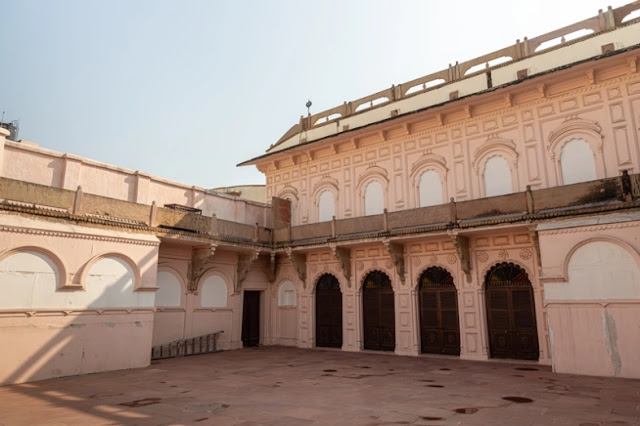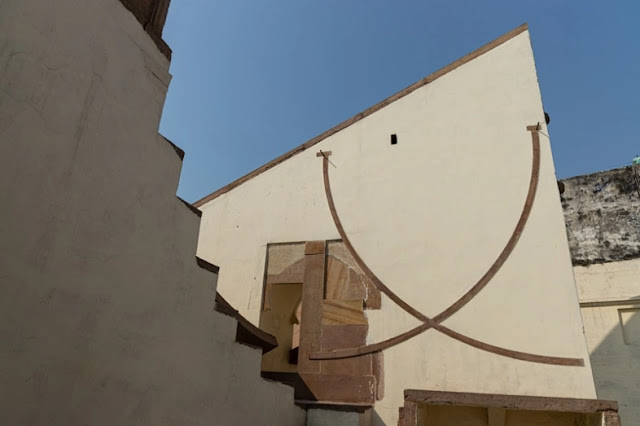Anyone who thinks they're important is usually just a pompous moron who can't deal with his or her own pathetic insignificance and the fact that what they do is meaningless and inconsequential. - William Thomas
Just general insignificance
Varanasi is said to be older than the traditions and the history of mankind too. The Ghats here are the ones that make the city more lively. Right from Assi to Aadikeshav Ghat each Ghat has its unparalleled importance.
One of these Ghats is Maan Mandir Ghat which is situated near the Dashashwamedh Ghat.
This Rajputana style of architecture Ghat is also known as ‘Maan Mahal’ and ‘Maan Singh Vedshala’. Earlier the name of this place was Someshwar.
The imposing Man Mandir Palace is one of the major central landmarks along the string of ghats that line the west bank of the great Ganga in Varanasi (Banaras, Kashi).
The palace was built in 1585 by the Mirza Raja Man Singh, the Rajput king of Amber (Jaipur in present day Rajasthan) and General of the Mughal Army.
The interior of the Palace has a number of rooms that act as a sort of information centre, although quite a lot of the space is very sparsely used.
A few artifacts are on display mostly relating to the Amber dynasty.
Being located so central to the ghats with literally thousands of visitors walking by every day, anyone would felt that a lot more could be done here to provide some detailed historical context to Varanasi. This is after all one of the oldest cities on the planet,
To be perfectly honest, The Man Singh Palace wasn’t for anything inside the building,
Despite the disappointment of the Man Mandir interior..the attraction of it was waiting on the roof. The roof of the Man Singh Palace has a surprise in stall or anyone with no prior knowledge of what to expect.
Here a set of futuristic looking astronomical instruments of a Hindu observatory Was Erected at Man Mandir Ghat Palace built by the astronomer (not astrologer) Sawai MahaRaja Jai Singh II of jaipur state in 1737, a descendant of Man Singh.
Which is One of the five oldest observatories in the world!
Sawai Jai Singh II
Sawai Jai Singh II was a great admirer of science and technology, and he was particularly passionate about astronomy. In the early 18th century he sent his scholars to several countries to study design, construction, and technology of observatories. The scholars returned with their observations and manuals on astronomy, after which Jai Singh embarked on a campaign of constructing his own observatories between 1724 and 1737 in five locations; Jaipur, Mathura, New Delhi, Ujjain and Varanasi.
Panoramic of the rooftop observatory
An architect named Sardar Mohan from Jaipur, who worked under the vigil and guidance of Sadashiva, accomplished his work.
This is three of the five such Hindu observatory survived in India, the others being in Jaipur and Delhi. The difference here is that the instruments have been distributed in quite a compact fashion across the split roofs of the Man Mahal, as opposed to being more dispersed in open space at ground level.
Despite the obvious limitations for space, most of the instruments in the observatories in Jaipur and Delhi can also be seen here, just not to the same scale.
plan of the instruments
Sadly the urbanisation of Varanasi in the proceeding 300 years since these instruments were built has rendered some of them non-functional in the early mornings and late evenings, as the sunlight is blocked by taller surrounding structures.
Some of the instruments you can see here are as follows :
Brihat Samrat Yantra
Sometimes known as the “Supreme Instrument”, the Samrat Yantra is an equinoctial sundial of enormous proportion. It measures time in a similar way to a sundial, but to a precision that had never been achieved before. the larger the Samrat Yantra, the more accuracy that can be achieved.
The two Samrat Yantras here at Varanasi are relatively small,
The largest one in the world can see is in Jaipur which amazingly is capable of measuring time to an accuracy of two seconds.
Dakshino Bhitti Yantra
This is used to measure the altitude of astral bodies.
It assisted in the calculation of summer and winter solstices as well as the equinoxes, and thus the progress of the seasons could be tracked.
Nadi valaya Yantra (Northern Hemispherical Sun-Dial)
This is an equatorial sundial used for measuring the local solar time at the latitude of Varanasi.
Chakra Yantra
This instrument measures the declination of the sun, moon and stars, together with their hour angle from the meridian.
Digamsha Yantra (Azimuth Instrument)
This measures the azimuth, the angle of an astral body relative to a specific observation point. This is the only instrument that is visible from ground level on Man Mandir Ghat, but all you can see is the hint of the curved outer wall.
Whilst you’re up here looking at the instruments, it’s well worth heading over to the east of the rooftop to catch a glimpse of the ghats below.
By the middle of the 19th century the observatory was in a dilapidated condition.
it was gradually sliding into decay. In 1912, Pandit Gokul Chand Bhavan, the then court astronomer to Maharaja Sawai Madho Singh of Jaipur, carried out major restoration work.
At the present this Ghat Palace is being looked after by the Indian Archaeological Department.
and the work of constructing a virtual museum at the Maan Mandir Ghat is under the process.
At present, it houses a Varanasi experiential museum created by Indian National Trust for Art and Cultural heritage @INTACHIndia inaugurated by the prime minister modi in 2019.
The Jantar Mantar instruments up on the roof are well worth visiting, especially if you have not recently seen their larger siblings in either Jaipur or Delhi.
These structures with their striking combinations of geometric forms still have a futuristic feel to them after 300 years, and offer something a little different in the ancient city of Kashi.




































No comments:
Post a Comment